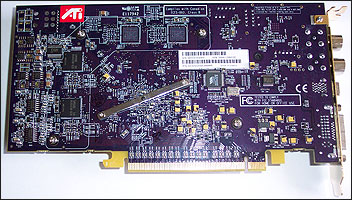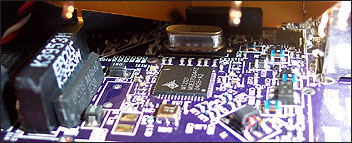Reference Board Examination
If you take a look at non-AIW X800 GT reviews you'll see that they likely use the cooler created by ATI for the X700 PRO. However all X800-based All-In-Wonders on PCI Express will use the cooler first seen on the Radeon X850 PRO, including the GT. All-In-Wonder boards from AIBs typically stick to the reference design and ATI's investment in the PCB design and cooler choice for the All-In-Wonder X800 XL is used on the dead-die X800 GT SKU. The definition of dead-die here is ATI's use of not-quite-fully-working 16 pixel unit R4-series GPU as 8 pixel unit GPUs for products like the X800 GT, using the two pixel quads that are fully functional. So look for the following board and cooler designs to show up from partners.The things to notice from the first two photograps are the spaces for the other DRAMs that an AIB would use to create a 256MiB, 256-bit memory interface version of the board, the X850 PRO cooler and the gold plate covering the Microtune tuner. Two of Samsung's ubiquitous GDDR3 DRAM devices are on the front side of the PCB, the other two are on the back as you can see, giving the All-In-Wonder half the memory size and half the interface width as the gamer's boards. They're rated to 500MHz (1000MHz), the GC20 marking telling you that. It's likely that the GC20 2.0ns part will be used by AIBs.
Current generation AIW products have a massive range of connectivity options for getting AV into and out of the board and they're all fed in via very limited backplane space. ATI use a custom connector on the backplane for everything that's not DVI or an antenna hookup for FM radio or television.
From left to right that's FM radio in, TV in (analogue or DVB-T), the custom connector and DVI (single link).
The multi-headed cable has an incredibly fiddly screw that's finely threaded,and the cable doesn't lend itself to straight-on-and-screwed-in-first-time success, although you only have to do it once. You can see analogue D-SUB 15-pin for a monitor, SCART output (via a VIA VT1632M), the port for connecting one of ATI's domino I/O blocks and an audio pass-through so the AIW can grab any line input you're feeding your sound board.
If you use a domino I/O input, you can get radio, analogue and digital TV, S-Video, composite video and stereo audio into the AIW while simultaneously outputting to DVI and either analogue VGA or SCART.
The tiny MT2121 silicon tuner is responsible for feeding the ATI Theater 200 video processor with a decoded AV stream from the FM and TV inputs and a NxtWave NXT6000 does the demod, some filtering and the error correction for the Microtune. Lastly, unlike the non-AIW X800 GTs, the AIW version is likely to almost exclusively use R430 GPUs.
To sum up, the All-In-Wonder X800 series on PCI Express is the most feature rich All-In-Wonder to date, able to tune FM radio, digital and analogue television (the MT2121 is locale-agnostic in terms of the DVB-T signals it can lock on to and tune and the NXT6000 similarly doesn't care what the MT2121 feeds it to demod and check, supporting world-wide DVB-T standards) and capture video using S-Video and composite connections. Output options are equally impressive with full dual output support from three connection options as standard, including the all important SCART.
With its single-slot, quiet cooler and inside-the-spec power requirements that allow it to be powered entirely from the PCI Express slot it stands out as ATI's flagship All-In-Wonder product. The AGP X800 XT version introduced the SCART connector, the PCI Express variants add DVB-T tuning to the mix.
So we've talked hardware, time to talk software since it defines the product at least as much as the hardware does in a product segment like the one AIW occupies. The old mantra of "if the software sucks, who cares what the hardware's like?" rings true here.














